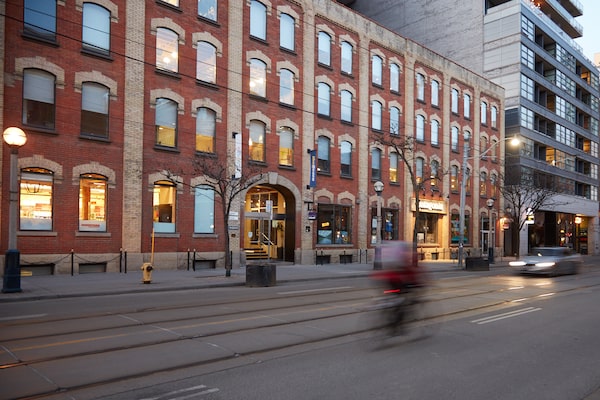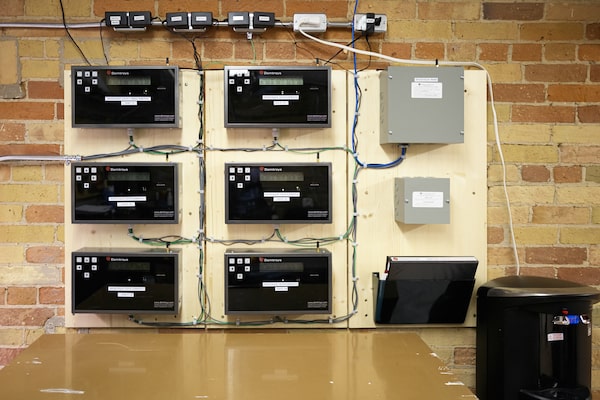
Allied Properties retrofitted this historic building at 500-520 King St. W. in Toronto.Thomas Bollmann/Thomas Bollmann
When Allied Properties Real Estate Investment Trust last year established a dedicated budget for energy and water conservation measures in some of its century-plus brick and beam office buildings, the results produced almost-immediate gains.
Instead of one-off upgrades, as before, Allied assessed its entire portfolio to identify those buildings with above-average utility costs, a reasonable rate of return for the proposed improvements, eligibility for government incentives and the potential to improve indoor comfort for tenants. With a budget of $2.3-million, including $350,000 in government incentives, Allied generated $1-million in energy savings in 24 buildings in just under two years.
Successful energy retrofits of commercial buildings, especially for Class B and C, are seen by conservation advocates as the next frontier if Canada, as pledged by the federal government, is to reduce its greenhouse gas emissions by 30 per cent below 2005 levels by 2030. Canada’s buildings represent 11 per cent of GHG emissions and are more energy intensive than those in other developed countries with similar climates, according to the federal government’s 2019 expert panel on sustainable finance, which targeted insufficient “deep retrofit” efforts in mid-size and smaller buildings.
“When it comes to existing buildings, the [real estate] industry has done a very good job in managing and retrofitting the larger office buildings in Canada,” says Thomas Mueller, president and chief executive of the Canada Green Building Council. “When it comes to Class B and C offices, the industry has done very little to improve energy efficiency or improved carbon performance.”
Those who have taken measures, he notes, incorporate practices such as staff training and tenant collaboration into their corporate culture.
Scott Rouse, managing partner of Energy@Work, which advises companies on shaving energy and utility costs, puts a premium on training front-line operators. Of 27 Toronto-area buildings his company tracks for energy performance, four are not hitting their targets. “Success depends on having a process, energy management products and trained people in place,” he says. “Often not hitting a target can come down to people issues because of inadequate training, not the process or products.”
One of his clients, Toronto-based Crown Property Management Inc., a commercial real estate investment and management firm, took advantage of then-available incentives from Toronto Hydro to map out an energy management “action plan.” For low and no-cost savings, the company revised schedules for lighting, heating and cooling, but also carried out formal energy audits. Building operators received regular training and over time, unprompted, spotted other cost savings.
As a result, eight of the company’s Toronto-area buildings cut kilowatt hour usage by 21 per cent over the past two years, as verified by Toronto Hydro.
“It is an awesome achievement when we save anything,” says Gary Summers, partner, operations and construction for Crown. “It allows us to put more our resources towards managing our tenants and working with them to stay.”
At Allied, the company in 2018 introduced a “sustainable well-being program,” with tools for benchmarking energy, water and waste performance; regular staff training; and tenant engagement strategies.
“It starts with measurement and benchmarking,” says Powell Talverdi, director of capital projects for Allied. “We want to know where we stand with energy and water consumption in each property: How do we compare against the industry? Where are the opportunities to improve? And when we do fall behind, we can understand what is happening.”

Allied installed smart controls to adjust for outside temperatures and indoor occupancy.Thomas Bollmann
When the company combined its own spending and government incentives to retrofit 13 buildings with LED lighting, the investment repaid itself in less than two years with an average 60-per-cent drop in lighting consumption.
In seven Toronto buildings, where electric baseboard heaters typically ran all winter, including on weekends, Allied installed smart controls to adjust for outside temperatures and indoor occupancy. With the new controls, the heat was off 77 per cent of the time, mostly during unoccupied hours.
Allied is currently installing automation systems in two large buildings to enable heating, cooling and other systems to communicate with each other to improve operational efficiency.
Tenant engagement is part of the overall strategy, says Barbara Ciesla, Allied’s vice-president of experience. With tenants, she says, “we form a ‘council of occupiers’ who work with us and inform the process. They let us know their objectives on sustainability and we share ours.”
On recycling, lighting reduction and other conservation campaigns, Ms. Ciesla says Allied and its 240 tenant organizations across Canada participate in “Partners for Sustainable Well-being” sessions, with the building owner and tenants committing to activities with collective impact.
“We try to include behavioural science into the campaigns, with incentives to start a [positive] behaviour and social norms to bring [tenants] together and share what each other is doing,” she says.
Government incentives speed up the payback period for conservation measures, but tenant satisfaction and leasing rate premiums also factor into the calculation.
“Whether there are incentives or not, there is clearly a business case to do energy efficiency projects,” says Bala Gnanam, vice-president of energy, environment and advocacy for the Building Owners and Managers Association of the Greater Toronto Area, which participates in a national environmental and certification program for existing buildings.
In Ontario, the Independent Electricity System Operator (IESO) agency that oversees the province’s electricity market, currently offers $141-million in retrofit incentives. But industry applications are lagging, possibly because of the COVID-19 pandemic.
Energy conservation “is the cheapest resource we have,” says Terry Young, vice-president of policy, engagement and innovation at IESO. The agency estimates that since 2015 its retrofit program has saved 4.2 terawatt hours of electricity savings, more than annual use by the city of London, Ont.
Industry veterans see no “silver bullet” for building retrofits.
BOMA Toronto chair-elect David Hoffman, the former general manager of the TD Centre (the first property in North America to produce a building-level sustainability report in 2013), cites target-setting and reporting, training, effective operational practices and occupant engagement as ingredients for success.
“It is not a sprint, it is a long marathon,” says Mr. Hoffman, general manager of CIBC Square, a downtown Toronto office complex now under development.
With the clock ticking on climate change pledges, many see the pandemic as an opportunity to redouble retrofit efforts that, by definition, would spur local employment and economic recovery.
“The amount of buildings we are retrofitting is well under 1 per cent of the existing building stock,” says Brendan Haley, policy director for Efficiency Canada, which advocates for an energy efficient economy. By contrast, some European countries have set a target of 3 per cent a year.
“We need to increase the rate of buildings done per year, but also the depth of the energy savings in the retrofits and move those buildings to low-carbon emission systems,” he says.
Even more blunt is Robert Sroufe, a business sustainability professor at Duquesne University and co-author of The Power of Existing Buildings.
“Commercial building owners who think they are not part of the problem might be part of the pollution,” he warns. “If they want to differentiate their companies, they need to invest in existing buildings and show they are places and spaces that people want to be in.”